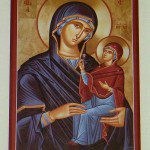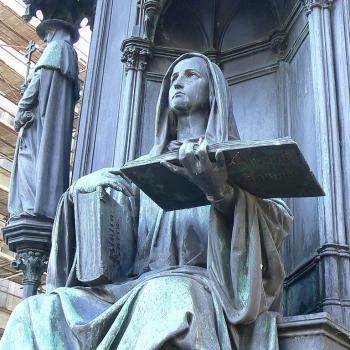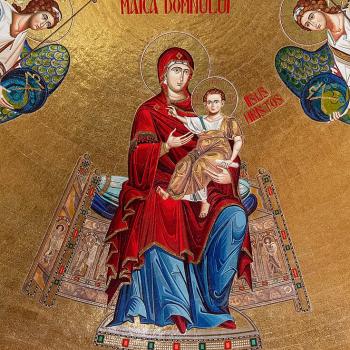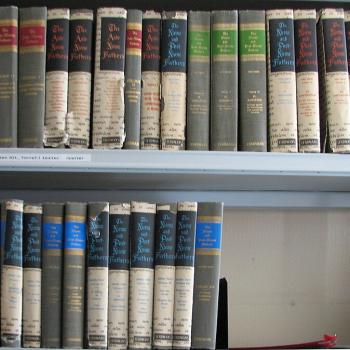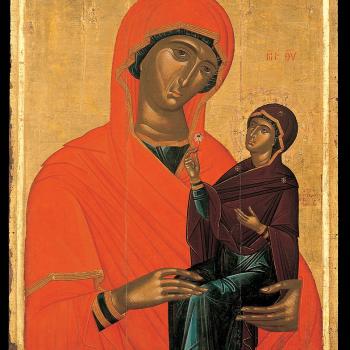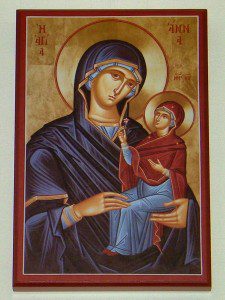
For Part I, click here.
St. Elizabeth, mother of St. John the Baptist, gave what could be seen as the first theological reflection on Mary when she proclaimed to Mary, “Blessed are you among women, and blessed is the fruit of your womb!” (Lk. 1:46 RSV).[1] The faithful have long known that there is something special, something unique, about Mary that sets her above every other woman, and that this special character was intricately connected to her role as the Mother of God. She who had lived her life as the humble handmaid of the Lord was exalted by God. In her life, in her self-giving to God, she resembled her son who, in the incarnation, emptied himself of all his glory so that he could come to us in a form which could see and understand and respond to in and with love. She was full of grace because she held nothing back from God; her humility opened her up so perfectly to grace that she could be seen as becoming one with it, and in that unity, she was without sin, and so fit to give birth to the Son of God. Even Augustine, who understood the deep rooted infection of sin in humanity, saw that the disease of sin did not hinder her, that she had a special relationship with grace that allowed her to have an entirely sinless life. Everyone, he said, had been infected to some degree to original sin, everyone, that is, except Mary. She was different, and was not to be included in such a general analysis:
We must except the holy Virgin Mary, concerning whom I wish to raise no question when it touches the subject of sins, out of honour to the Lord; for from Him we know what abundance of grace for overcoming sin in every particular was conferred upon her who had the merit to conceive and bear Him who undoubtedly had no sin.[2]
Mary, because she was full of grace, must have perfectly followed and engaged with grace since the moment of her conception, and continued to open herself to it and its direction at every point of her life. Anything else would have meant she did not achieve the full potential of grace, and so could not really be described as “full of grace,” for whatever grace she had resisted would be grace she did not possess in her being, and so would be that which left her less than full of grace. But as the angel declared, she had, thanks to her cooperation with God, fulfilled her potential and those with perfect spiritual vision could see her for what she was, full of grace. It was grace which allowed her to be conceived without sin. It is grace which gave her the strength throughout her life to remain without sin. Her whole life was lived out as a constant yes to God and to God’s grace. And yet it is because she constantly said yes to God from the moment of her conception onward that she received grace upon grace and became so abundantly full of grace that, thanks to that same grace, she became the Mother of God.
Why and how was Mary chosen for this role, so that she received the grace she had which freed her to make a perfection decision for God? Why, if she received this grace, did others not do so? Was it some arbitrary decision on God’s part? Clearly not, because that is not how God acts. While we must accept that God’s decisions transcend our comprehension, and there remains an element of a mystery to them, this is not because they lack any sort of logic to them, but because God’s logic reflect multiple calculations concerning the inter-relationship between eternity and time. Similar to the paradoxes which we have already discussed as to how time and eternity work together in Jesus, those paradoxes continue in all discussions concerning the way God works with anyone in time. And so, while we can and must reflect upon these questions, and find some ways to answer them, we must remember, any and all explanations pale in comparison to the transcendent mystery which lies behind them, and all such explanations will therefore be imperfect, giving us a reasonable or fitting answer, but never a comprehensive one.[3]
As we shall see, Mary’s grace must be seen as something brought out by God in and through history. We will find as we further explore the question that God’s grace could be seen to be slowly added to and put in into family line which led to Mary. The family tree was slowly made ready for her and her son, Jesus Christ. It was the end product of a series of yeses within the line of David, yeses to one aspect or another of God’s calling which allowed for more and more holiness, more and more of God’s grace, to find a place within human history. It was collected, as it were, until at last Mary was conceived. The grace behind that conception was demonstrated by the miracle which allowed Mary to be conceived. Her parents, Sts. Joachim and Anne, had for many years desired to have children of their own. While feeling the heartache of childlessness they never gave up hope, never gave up faith in God, and at last, when Anne was at an elderly age, Mary was conceived and born.[4] That which is impossible for us to do by ourselves is possible by God, and, as was often the case in Jesus’ ministry, the miracle of her birth was a way God worked to show to us his administration of grace in Mary’s conception.[5]
Thus, instead of a singular act of God without relation to history, the immaculate conception is the end product of the work God accomplished in and with humanity, in and through the line of David, to produce the Theotokos. There was no arbitrary act which led to her conception, that is, it was not as if God suddenly, and without any precedent, graced Mary to be without sin, acting, as it were, deus ex machina. Rather, he worked long and hard in Israel in order to have her, “Daughter Zion,” born.
While the glory rendered to Mary is worthy of praise, because such praise honors the work of God, we must remember her glory relates to and points to the infinitely greater glory of her son, Jesus. As we have already said, reflections on Mary concern Christological issues. Discussing about her own personal holiness is important because it is not just about her, but about the perfection found in Jesus’ human nature. His humanity is important, and as the Gospels show, it is rooted in history and not established independent from it. That why his genealogy is found in the Gospels. He is one with us with a real (not illusory) line of ancestors. Jesus really came in the flesh, connected to us and our humanity through his mother, Mary. And his sinlessness, like his humanity, did not come out of nowhere and make him independent from the rest of humanity.[6] Similarly, what he had was itself established in and through the rest of her ancestors, through her family line, until the perfection of the line itself was found in her. What she had was thanks to the work of grace in history, and so it was what she was free to offer to God and give to her son, Jesus. She is the sole source of his humanity, so all she had of it, was all he would be able to possess. If there were some imperfection in her, so would there be imperfection in him.[7] Since we know he was perfect, so the source of his humanity, Mary, must have been perfect as well, thanks to the grace of God.
More to Come Next Weekend
[1] Scripture, therefore, can be shown as giving us the words of what amounts to the first Marian Creed, a creed which continues to be put to use by many of the faithful in their praying of the rosary.
[2] St. Augustine, On Nature and Grace in NPNF1(5): 135.
[3] Such an understanding will, by its nature, also be somewhat speculative, with all the qualifications and limitations associated with such speculation to be understood as well.
[4]Church tradition explains how Sts. Joachim and Anne found themselves scorned by others, treated as sinners, because they seemed to be unable to have children. And yet, despite what any had said of them, they lived honorable and holy lives. They prayed long and hard, never giving up hope that they may be blessed by God and have a child of their own. Their long hardship, which lasted decades, allowed their righteousness to be tried and found true. Their love for each other, as well as their love for God, was pure. In this fashion, they were able to come together one special night of pure love and conceive Mary, the Theotokos. The grace of God came to them in and through their prayers, joining them with their love, so that Mary was established in a purity of love mixed with grace, allowing her to be, from the foundation of her being, perfectly united to God in love.
[5] An example of this is in the Gospel of Luke, when we see Jesus forgiving the sins of a paralyzed man. The Jewish authorities found this to be blasphemous. While it would be easy for anyone to tell the man his sins were forgiven, Jesus’ authority to forgive had to be proven and this was done via miracle:
And the scribes and the Pharisees began to question, saying, ‘Who is this that speaks blasphemies? Who can forgive sins but God only?’ When Jesus perceived their questionings, he answered them, ‘Why do you question in your hearts? Which is easier, to say, `Your sins are forgiven you,’ or to say, `Rise and walk’? But that you may know that the Son of man has authority on earth to forgive sin’ — he said to the man who was paralyzed – ‘I say to you, rise, take up your bed and go home.’ And immediately he rose before them, and took up that on which he lay, and went home, glorifying God. And amazement seized them all, and they glorified God and were filled with awe, saying, ‘We have seen strange things today’ (Lk 5:21 -26 RSV).
St. Anne’s conception of Mary at an elderly age was meant to be a sign of God’s bountiful grace in Mary’s life. His grace was given to her at the moment of her conception, a conception which should not have been able to take place, and would not have taken place save for God’s dispensation. Her conception was accomplished in this manner so that we can see how she was conceived in grace, allowing us to understand how she, from the very first moment of her life, was filled with grace, and so could have lived a life free from personal sin.
[6] If we were to view sin as inherent to humanity, than Jesus could not be human. But since he is human, we are open to see humanity can exist in purity, without sin, and so acknowledge that, thanks to grace, someone can be sinless and human.
[7] As we will discuss later, Mary being the sole source of Jesus’ humanity differs from Mary having two sources for hers. What is rendered to her is, in this way, different from what is rendered to Jesus: God had much more material to work with to establish human perfection in Mary, while with Mary, there was only her and what she had which could then be used for the production of her son. The conception of Mary thus allowed God to take elements from both her parents and use what is found in one to complement and make whole what is lacking in the other, while with Jesus, since Mary is the sole source of his humanity, there would have been no source to complement any lack if any lack existed in her to produce him.
Stay in touch! Like A Little Bit of Nothing on Facebook:
A Little Bit of Nothing


